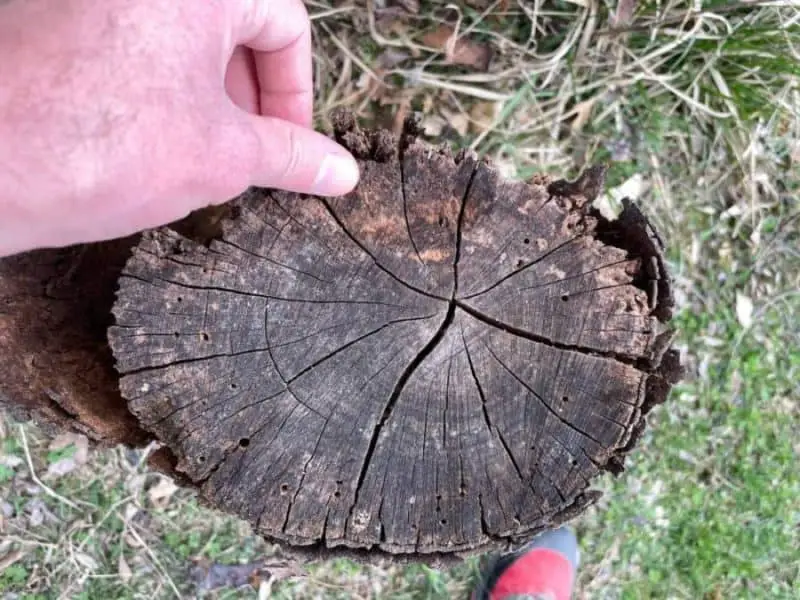Yikes – I hope my daughter never asks this question about me. I can hear it now – “Hey Dad, are you TOO old?”
Hopefully she’ll have better manners than that. But if not, at least I can make sure she knows stuff about firewood.
Speaking of which, let’s get to today’s question: Can firewood get too old?
Practically speaking, firewood never gets too old. If it’s kept dry and stacked properly, firewood could last for 10+ years. However, firewood does decompose (and can even mold) when it’s exposed to the elements or stored improperly. Age is secondary.
With that said, this probably opens up another can of worms.
If we assume your firewood IS exposed to the elements (for example: if it’s stored outside without any cover), then how can you tell if it’s okay to burn? And how much difference does the species of firewood make (hint: BIG difference).
We’ll cover all that here, so consider this your one-stop shop for your questions about aging or decaying firewood. Here’s a list of the topics so you can jump to the one you care most about:
- How can you tell if firewood is bad?
- 4 factors that determine firewood’s lifespan
- Can you overseason firewood (can it get too dry)?
How can you tell if firewood is bad (or rotten)?
For firewood to “go bad” or “be rotten” really just means that the wood is decomposing. This is the natural process that takes the carbon and other materials within the firewood, and converts it back into soil.
When wood initially begins to decompose, you’ll start to notice that the wood is getting “softer” around the edges.

And eventually, the wood will decay so much that it may crumble into soil-like pieces in your hands if you pick it up.
Here’s an example of a piece of Cherry firewood that has undergone significant decay:

Notice that the wood is soft, dark, and crumbly. In other words, it’s starting to look like soil.
If you find a piece of wood that looks like this, then yes, it is decaying. BUT, that doesn’t necessarily mean you can’t burn it.
Can dead wood burn?
Dead wood will still burn in most cases, but you may want to avoid burning it in a wood stove or fireplace. Wood that has decayed significantly tends to have a higher moisture content than is recommended for wood stoves and can burn “dirtier” and contribute to more chimney creosote build-up compared with healthy dry wood.
What do you do with rotten wood?
On the other hand, if I were planning to use the decaying wood for a campfire or backyard fire pit, then I wouldn’t have any problem using it for that purpose.
Even though it’s starting to break down, it’s still wood and doesn’t really “expire”.
With that said, it is possible for firewood to get moldy, so let’s talk about that for a moment.
Can firewood get moldy?
Mold can grow on firewood under the right conditions and moldy firewood is a more significant issue than simple wood decay. If you see mold on a piece of firewood, you probably shouldn’t burn it.
You would want to be especially careful to avoid mold if you have asthma or mold allergies of some kind (disclaimer: I’m not a doctor), or if you were planning to use it for cooking.
With that said, stacking your firewood in a way that allows good airflow and sun exposure should prevent any mold from growing on your firewood. Moisture is the main thing that attracts mold, so if you can keep your wood dry, then it will usually also be mold-free.
The 4 factors the determine firewood’s lifespan
Now that you’ve seen what decaying wood looks like, let’s cover the 4 main things that impact the life span of your stored firewood:
- Tree species
- Moisture / location
- Stacking
- Cover
It is NOT an exaggeration to say that the 4 factors above can mean the difference between firewood that starts decomposing within it’s first 10 months, and firewood that lasts for over 20 years.
So let’s dig deeper into each point, because this is the info that will help you distinguish between a pristine firewood stack and one that is doomed to decay (or already decayed).
1. Tree species
Perhaps the single most important factor that affects the longevity of a given piece of wood, is the species of the wood.
A little over a year ago, my Dad dug up a small black locust log. He estimated that it had been there for over a decade, and it was still in excellent condition despite being outdoors and completely exposed to the weather.
If you’re not already familiar with black locust, it is a very dense hardwood and it is actually MORE rot-resistant than pressure-treated lumber. So regardless of the conditions, it tends to last a lot longer than a less resilient softwood like pine.
There is a huge variety of different species of firewoods, and there are multiple factors that impact their levels of rot resistance. But in general, the denser the wood the longer it is going to last (all else equal). If you’d like to see a short list of common firewood species and their comparative weights, check out this post. The top few species mentioned are the densest.
2. Moisture / location
Next up, we’ve got to talk about weather and moisture.
If you live somewhere that is naturally hot and dry, then your firewood is going to last a long time. For example, if you live in the desert regions of Nevada, Utah, or Southern California, then congrats. You’d have a very easy time keeping firewood for the long haul.
On the other hand, if you live somewhere that is quite rainy (like the Pacific Northwest) then you will need to cover your firewood or put it in a shed to help it last longer.
But it’s not just rain that is an issue. The natural humidity in the air can also increase the moisture content of firewood and cause it to gradually decay. In America, the Midwest (i.e. Indiana, Michigan, etc.) and the Southeast (i.e. Florida, Louisiana, etc.) are among the most humid regions.
But, even if you live in an area that is humid or rainy / snowy, you can still get your firewood to last many years if you do well with the next few points.
3. Stacking
Wood that is in a haphazard pile, directly on the ground, will decay quickly. This kind of stack will allow the moisture from the ground to affect the wood that is on the bottom. In addition, moisture will get trapped in the wood that’s on the inside of the pile.
On the other hand, if you use stacks that allow for good airflow and optimal sun exposure, then you’re going to extend the life of your firewood significantly (potentially by years).
To allow for good airflow, make sure that you don’t make your stacks too close to a building or other stacks. Allow at least a few feet between your wood stack and anything else. And if you have a certain area of your property where you get the most breeze, then that might be an excellent location for your firewood stacks.
To allow for optimal sun exposure, you can point the face of your stack (i.e. the longest side of the stack) South, because that is the direction which gets the most sun. At least in North America.
It also helps to elevate your stacks, to protect the bottom row from ground moisture.
4. Cover
Firewood that has the top covered will last longer than wood that is completely exposed to rain / snow.
But let me be clear, you should NOT completely cover your firewood stacks with a tarp. This traps the moisture in and eliminates airflow, which is bad.
If you must use a tarp, you should only cover the top of the stack, and suspend the sides of the tarp so that it allows sunlight and airflow to penetrate the sides of the stack. If you have access to a woodshed with exposed sides, that’s even better.
Now we need to make one final distinction. If your firewood is already seasoned, then storing it indoors in a barn or shed, could make it last even longer by further isolating it from the weather.
Can you overseason firewood?
If you’re thinking about the life span of firewood, then you might also wonder if firewood can become overseasoned (i.e. too dry).
Under normal circumstances, firewood does not become overseasoned or too dry. However, if firewood is kiln dried or exposed to extremely dry and hot conditions, then it’s possible for the moisture content to fall below the ideal range of 15-20%, which causes the firewood to burn more quickly and less efficiently in wood stoves.
Now you know.
